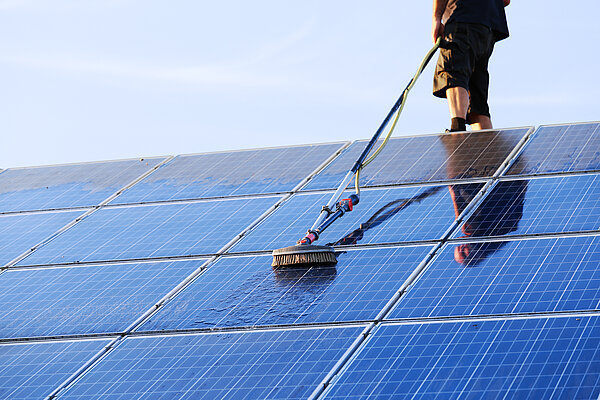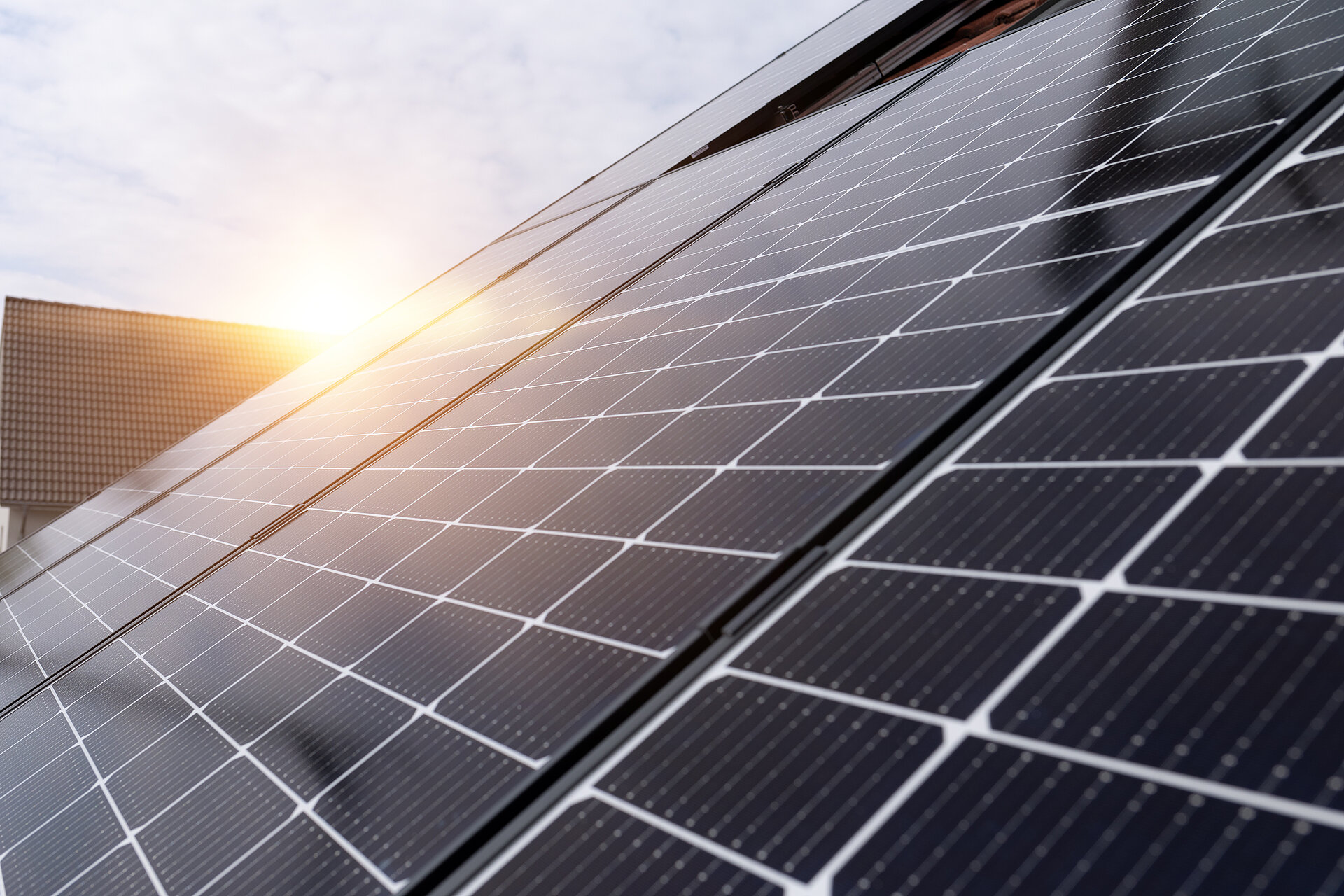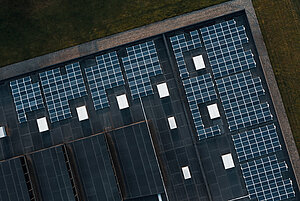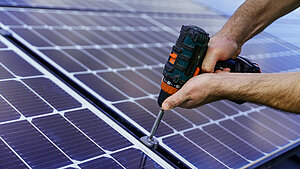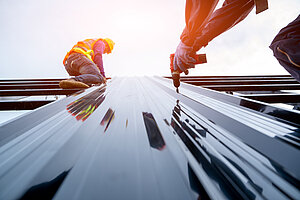And: this is how you create a consciousness for this essential area with potential PV system operators.
The most frequent sources of danger on a roof:
- Roof edge – this must be made safe against falls
- Skylights – the risk of a breakthrough exists here
- Stumbling – such as exposed pipes, lightning protection, etc.
- and: The statics of the roof must be tested in advance, because a PV system can be installed on a roof only if the statics are in order.
The most frequent access routes onto a roof:
- through the roof – e.g. through a skylight or a roof window
- by means of ascent aids – ladders or scaffolding
- through windows/doors in the facade of a higher connected building
Attention: As soon as the ascent aid is accessed, the users are positioned in the danger area. This also applies to windows as soon as they are open. It is therefore advisable in every case to consider very closely in advance where the ascent is to take place, and how this can be made as safe as possible.
Project initiation and inspection of the property
At the outset it should be mentioned that, when inspecting or accessing the roof, every person must be protected by means of temporary fall protection. This means that all necessary safety precautions must have been taken by the time of the project initiation. As well as using PPE, skylights can for example be optimally secured using the EAP-MOBI system for the access period. This system can also act as a temporary anchor point. This also has the benefit that clients immediately get a good feeling, and feel themselves to be in safe and expert hands.
In addition, the confidence in the solar system installer will increase even further when he recognises all danger areas on the roof and discusses them with the client. If the partner whom you rely on is a certified and absolutely reliable manufacturer of fall protection for PV installations on a roof, you are also immediately able to offer a suitable safety concept in terms of the best possible fall protection for the respective solar power plant. This not only creates confidence, it also brings a significantly higher turnover volume per order. It is also a good time to emphasise the benefits of a professional, certified fall protection system.
Indeed, from experience we know that many operators of PV systems on a roof choose improvised safety solutions for their solar power plant, without however knowing how these actually react to the enormous loads from a fall in an emergency. This is where an illusion of safety can arise.[US1] And this can work out expensive, much more so than a reliable, certified fall protection system perfectly adapted to the situation.
Tip: Undergo an extensive training programme, such as the PPE training from INNOTECH, and also recommend this to your PV customers. The modules teach all details related to our fall protection systems. And they also go into detail about the illusion of safety.
Access
If, for example, access takes place via a window, the protection can be provided in the interior – using EAP-LOCK-11. This receptacle sleeve from INNOTECH is attached permanently to the building structure and covered with a protective cap when not in use, and is therefore completely inconspicuous. The best way to protect access via a ladder is to use vertical cable and rail systems. These include, for example, TAURUS VERTICAL and the VERT LIFELINE SYSTEMfrom INNOTECH. For every danger area, we offer the optimum protection against falls from a height. This is also a huge benefit for PV customers, because they can then compare all available systems, and then make a solid decision on the fall protection which best suits them.
Info: Not all ladders are the same. In practice, a distinction is made between simple ladders and permanently installed ladders. Simple ladders are permitted only up to a height of 5 metres. Above this, permanently installed ladders with an appropriate safety solution – such as the VERT LIFELINE SYSTEM or the TAURUS VERTICAL – are mandatory. But the exit area of a ladder onto a roof must also be secured against falling. This is where the BARRIER ASCENT LADDER is a good option. You can see the importance of considering a project holistically!
The transition
The transition from the ladder or the window to the roof is certainly one of the most dangerous moments, because the users are generally also carrying cleaning equipment or tools, and do not always have both hands free. Regardless whether the users climb onto the roof from the interior via a window, or from the exterior via a ladder, the first anchor points must be within comfortable reach, in order that the users can secure themselves appropriately, so as to get to the next anchor point.
For access from the exterior, the transition area can also be secured using a rail at the side, such as the BARRIER ASCENT LADDER, in order to make the exit from an ascent ladder onto the roof surface absolutely safe.
Tip: For the transition to a flat roof where the PV system is located, collective protection such as the BARRIER ASCENT LADDER is ideal for protecting against falls.
On the roof
In terms of safety technology, the PV system on a roof is always a challenge, because numerous obstacles, such as chimneys, satellite dishes, skylights, air-conditioners, or other anchor points are located on the roof. And in addition, falls through the roof are increasingly frequent. However, professional safety solutions are available for all these challenges. That is why every detail always needs taking into account when selecting the appropriate fall protection or safety system for the PV installation on a roof – even as early as the planning stage.
Here, above all, the respective fall height is important, but so too are the ground plan of the building and the onsite climatic conditions, because in especially cold or rainy areas the dangers which threaten differ from those in warmer climes. It is also of decisive importance to always select the correct PPE (personal protective equipment) against falls, as well as the correct lanyards – PSA-BRAKE or PSA-STRING – and also the right harness for PPE - PSA-STRING-1-BASIC or PSA-STRING-1-COMFORT, so that all tasks on a roof can be performed in safety.
Attention: If a fall occurs, a canopy or garage also reduces the fall height. Consider this fact when selecting the safety solution and the use of the PPE. Here, the lanyard requires particular attention. This needs to be shortened to use the system only as a restraint system, rather than as a fall arrest system.
Also remember that tasks on the roof must always be carried out by two people. While one person performs the repairs or cleaning tasks, from within the protected area the second person must keep an eye on everything, and instigate appropriate measures in the event of an emergency. It is therefore advisable to order all PPE modules at least in duplicate.
Long-term customer relations and increased turnover
A holistic consideration of your projects, with a corresponding recommendation for professional and certified fall protection systems can do more than just bring you increased turnover. For solar system installers, it also opens the option to create very long-term customer relations, such as a maintenance contract for the fall protection system, which in any case by law must be inspected every year.
Note: The facade is a further source of danger which may also be relevant in the case of PV systems. You will find all relevant details here.
Summary
Solar system installers who have a professional partner for fall protection systems can present themselves as highly expert and responsible providers of PV systems, because they simultaneously provide a safety solution. However, it is important here that all details of the respective order are taken into account, in order to neutralise all danger sources in the long term. PV system operators really appreciate this, because in this way they have absolute legal certainty and protect lives.
Contact us immediately for further information. Our experts will be pleased to discuss with you the benefits which you enjoy as a solar system installer when you work together with INNOTECH. And: download our checklist/tips on this topic now!








![[Translate to Englisch:] [Translate to Englisch:]](https://www.innotech-safety.com/fileadmin/_processed_/1/a/csm_Mehrere_PV-Kunden_gleichzeitig_betreuen__kann_oft_zur_Riesenherausforderung_werden-header_c1a520d846.jpg)
















